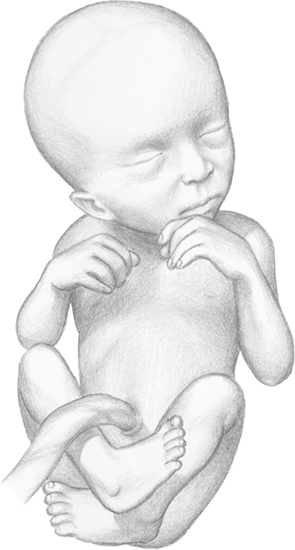1. How Big Is Your Baby?
The crown-to-rump length of your baby is
4½ to 4¾ inches (11 to 12cm). Fetal weight has doubled in 2 weeks and
is now about 3½ ounces (100g). By this week, your baby is about the
size of your hand spread open wide.
2. How Big Are You?
Your uterus is 1½ to 2 inches (3.8 to
5cm) below your bellybutton. You now have an obvious swelling in your
lower abdomen. Expanding or maternity clothing is a must for comfort’s
sake. When your partner gives you a hug, he may feel the difference in
your lower abdomen. A total 5-to 10-pound (2.25 to 4.5kg) total weight
gain by this point in your pregnancy is normal.
3. How Your Baby Is Growing and Developing
Fat, also called adipose tissue,
begins to form this week. It’s important to baby’s heat production and
metabolism. At birth, fat makes up about 5¼ pounds (2.4kg) of the total
average weight of 7¾ pounds (3.5kg).
You have felt your baby move, or you will
soon. You may not feel it every day. As pregnancy progresses, movements
become stronger and more frequent.

Your baby’s fingernails are well formed.
The baby is beginning to accumulate a little fat.
4. Changes in You
Feeling your baby move can reassure you
things are going well with your pregnancy. This is especially true if
you’ve had problems.
As pregnancy advances, the uterus becomes
more oval than round as it fills the pelvis and starts to grow into the
abdomen. Your intestines are pushed upward and to the sides. Your
uterus eventually reaches almost to your liver.
When you stand, your uterus
touches your abdominal wall in the front. You may feel it most easily
in this position. When you lie on your back, it can fall backward onto
your spine and blood vessels (vena cava and aorta).
Round-Ligament Pain
Round ligaments are attached to each
side of the upper uterus and to the pelvic side wall. With the growth
of the uterus, these ligaments stretch and pull, and become longer and
thicker. Moving may cause pain or discomfort called round-ligament pain.
Pain may occur on one side only or both sides, or it may be worse on
one side than another. This pain does not harm you or your baby.
If you have this pain, you may feel
better if you lie down and rest. Talk to your healthcare provider if
pain is severe or if other symptoms arise. Warning signs of serious
problems include bleeding from the vagina, loss of fluid from the
vagina or severe pain.
Tip for Week 17
If you experience leg cramps during
pregnancy, there are some things to try. Don’t stand for long periods.
Rest on your side as often as possible. Do stretching exercises. You
may also use a heating pad on the cramped area, but don’t use it for
longer than 15 minutes at a time.
Eat raisins and bananas—they’re great sources of potassium.
Inadequate calcium intake can also
affect leg cramps. Be sure you take in 1200mg of calcium every day.
Drinking lots of water may also help.